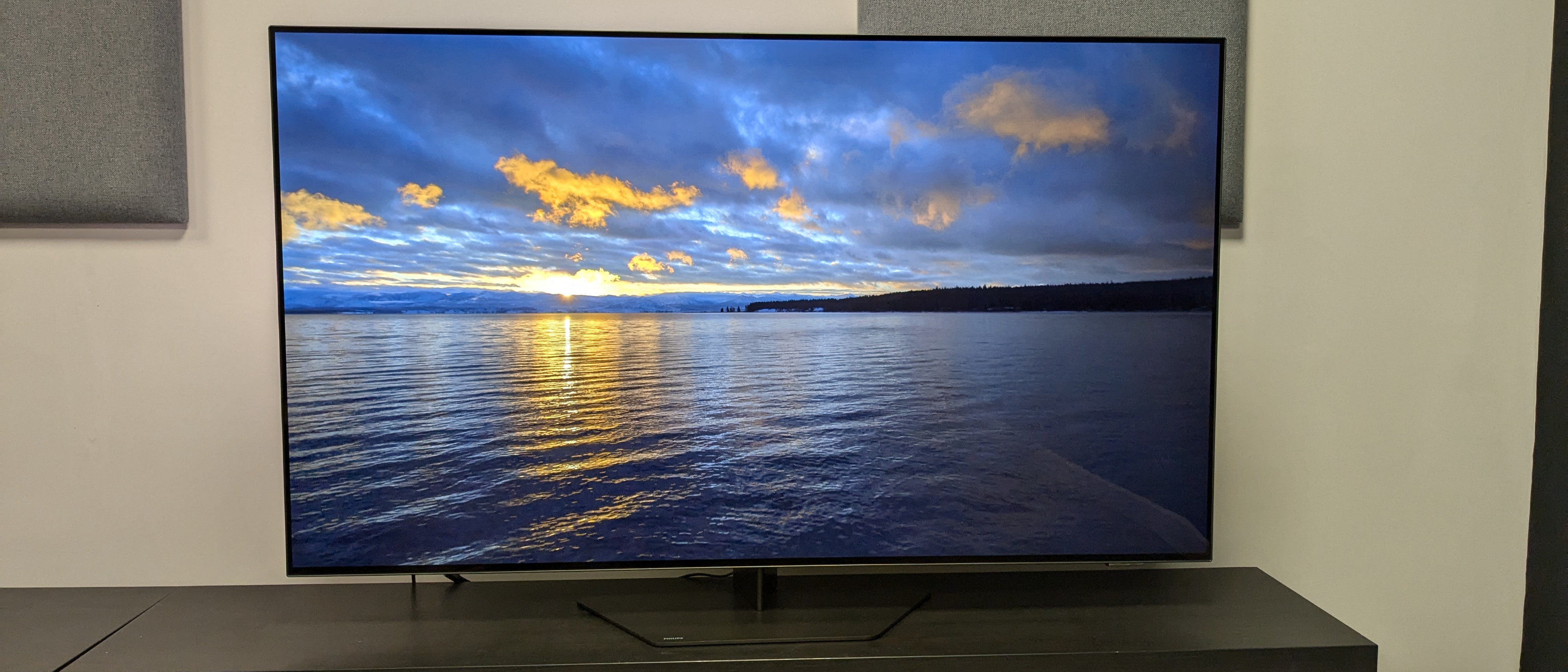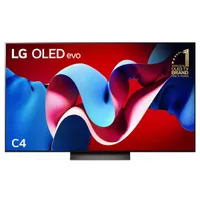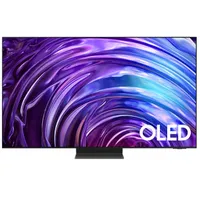TechRadar Verdict
The OLED809 is yet another home run for Philips, delivering stunning pictures and surprisingly good audio. Its unique Ambilight feature continues to set it apart from other OLEDs and although it's not a perfect TV, it's still going to give the LG C4 a run for its money.
Pros
- +
Spectacular picture
- +
Immersive Ambilight feature
- +
Great built-in audio
Cons
- -
Upscaling is lacking
- -
No Freeview Play apps
- -
Limited to two HDMI 2.1 ports
Why you can trust TechRadar
Philips OLED809 review: Two minute review
The Philips OLED809 enters into a competitive mid-range OLED TV market, pitting itself against some of the best OLED TVs available such as the LG C4 (its main 2024 rival) Sony A80L and Samsung S90C – and it stands toe-to-toe with them, cementing itself as one of the best TVs of 2024.
Picture quality on the Philips OLED809 is excellent, with rich contrast and the stunning blacks and shadow detail you expect from an OLED TV, while also showcasing vivid colours and crisp details that appear natural and realistic. Working in tandem with Ambilight, it’s a stunning TV for those seeking a unique movie experience. Its motion handling can be a bit inconsistent and it requires some adjusting to suit different content (movies, sports) but the picture quality overall here is fantastic.
The OLED809’s Sound quality surprises in the best way and while its built-in speakers won’t beat one of the best soundbars, it’s solid enough that some won’t feel the need to add a soundbar. Bass levels are punchy but controlled, dialogue is clear and the placement and direction of sounds on screen also feel right. It doesn’t quite beat some of the best TVs for sound such as the Panasonic MZ2000 as its soundstage feels on the narrow side and Dolby Atmos effects aren’t overly apparent, but it does a good job nonetheless.
Design is an OLED809 highlight, with the spectacular Ambilight feature that projects coloured lights onto the wall behind adding an extra, unique factor that immerses you in whatever you’re watching or playing. The 55-inch model I tested comes with a swivel stand that is both helpful and sturdy and its trim profile and supplied remote give it a premium feel even at a mid-range OLED TV price.
Google TV is a functional smart TV platform that while not the best on the market (look to LG’s webOS) still offers a tailored experience with plenty of settings for those who like to play around with their picture. Sadly, it doesn’t come with Freeview Play and its associated apps such as BBC iPlayer and ITVX, but this can be solved by adding a streaming device like the Amazon Fire TV Stick 4K.
The OLED809 is an accomplished gaming TV, with plenty of features that will keep Xbox Series X, PS5 and even PC owners happy, such as 4K 144Hz, VRR (in HDMI, AMD and Nvidia forms) and Dolby Vision gaming support, and it has smooth performance to match. Having only two HDMI 2.1 ports holds it back from beating the likes of the very best gaming TVs, but it’s still sure to give many gamers a good time.
For what it offers in terms of features and performance, the OLED809 is great value and rivals other mid-range OLEDs, most notably the LG C4 – arguably its most direct competition. It’s still at the premium end of the TV market but is nonetheless fairly priced for what it delivers.
Sign up for breaking news, reviews, opinion, top tech deals, and more.
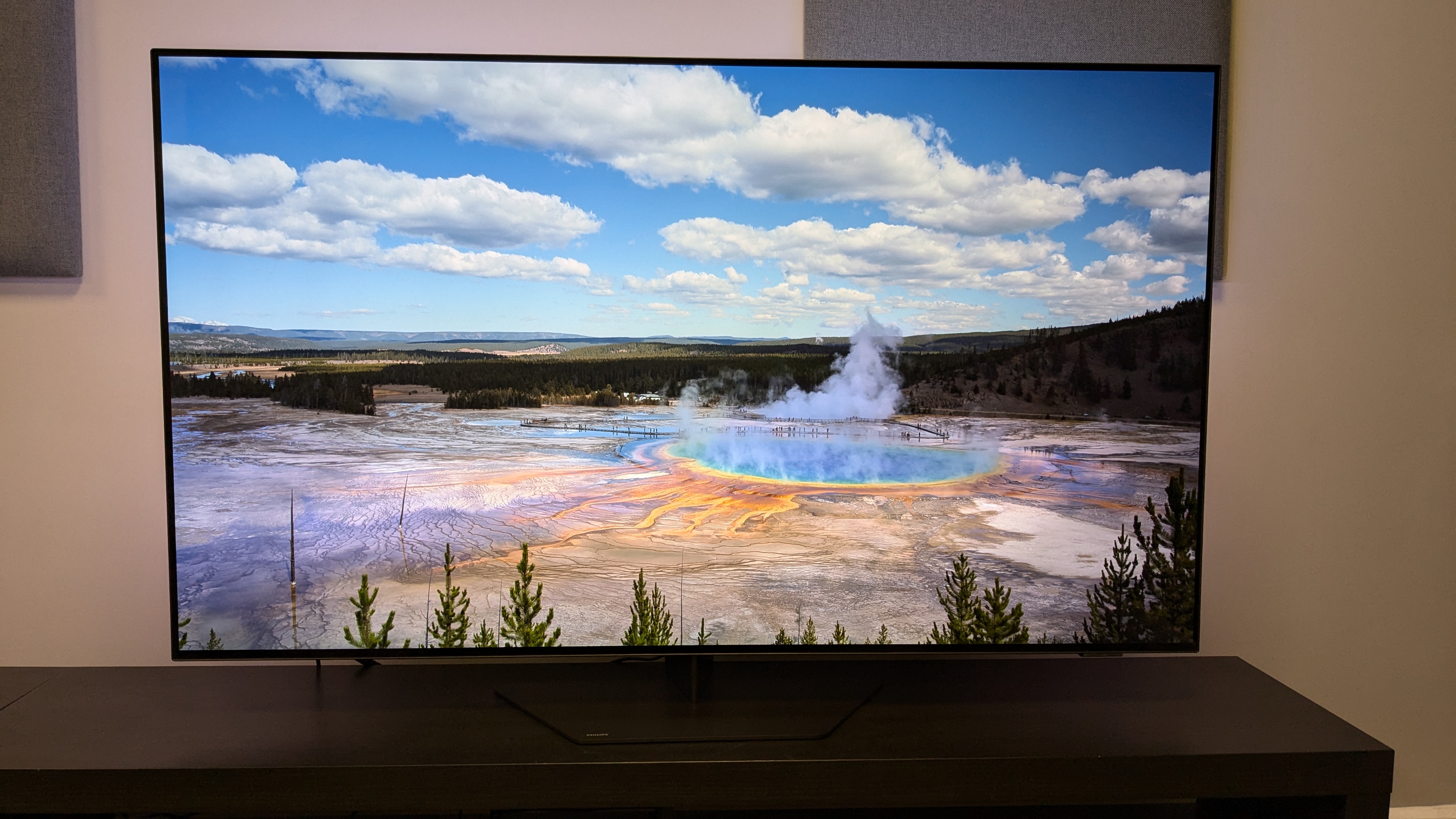
Philips OLED809 review: Prices & release date
- Release date: July 2024
- 42-inch price: £1,299
- 48-inch price: £1,299
- 55-inch price: £1,499
- 65-inch price: £2,099
- 77-inch price: £3,499
The Philips OLED809 is one of the mid-range OLED models in Philips’ 2024 TV range, sitting above the OLED759 and below the OLED909 and flagship OLED959. It is available in a wide range of sizes including 42, 48, 55, 65 and 77-inch – nearly the same size range as the LG C4.
The OLED809’s pricing is also similar to the LG C4, with the 55-inch model I used in my testing currently priced at £1,499 vs the C4’s £1,499. There are also discounts across the entire OLED809 range (ranging from £100-200) only a few weeks after release.
Philips OLED809 review: Specs
Screen type: | OLED (EX) |
Refresh rate: | 144Hz |
HDR support: | Dolby Vision, HDR10+, HDR10, HLG |
Audio support: | Dolby Atmos, DTS:X |
Smart TV: | Google TV |
HDMI ports: | 4 (2x HDMI 2.1) |
Philips OLED809 review: Benchmark results
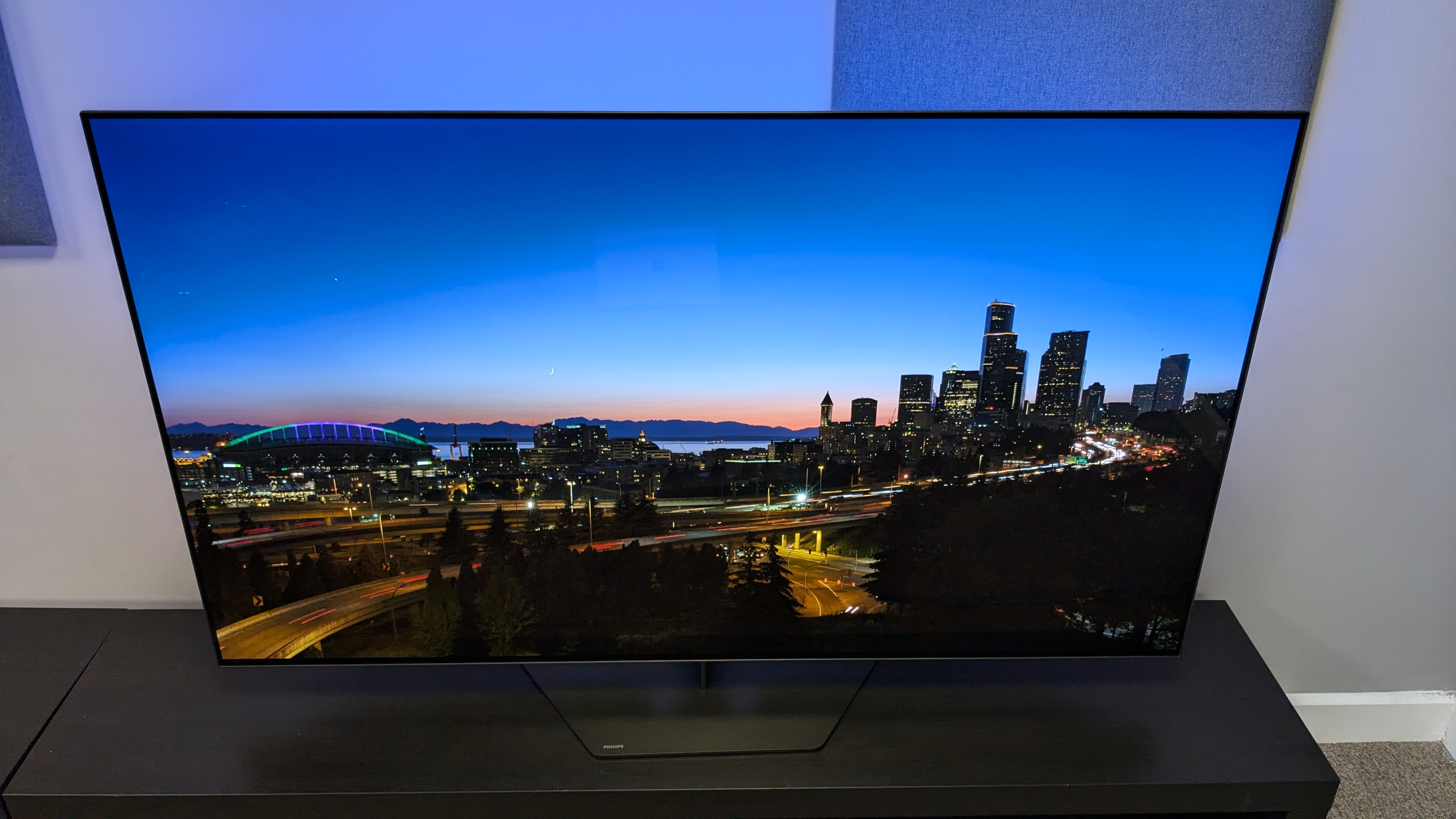
Philips OLED809 review: Features
- Three-sided Ambilight
- Philips P5 AI Processor
- No Freeview Play apps
The OLED809 features an OLED EX panel, the same that can be found in the LG C4, for a brightness boost over a standard W-OLED panel (though it’s worth noting that the 42 and 48-inch OLED809 models use this standard W-OLED panel). However, it doesn’t come with Micro Lens Array (MLA) tech used in Philips’ flagship OLED909 and OLED959 models that even further boosts brightness.
For HDR support, the OLED809 is well equipped, featuring both Dolby Vision and HDR10+ Adaptive for both movies and gaming. It also supports IMAX Enhanced, and comes with a picture mode designed for Calman calibration.
The OLED809’s most eye-catching feature is of course Ambilight – a tech used to project lights onto the wall behind the TV itself. It has several customisable modes, from solid colours, which can be adjusted to match a tone or mood, to projecting colours that follow the content on screen, and there are options to follow audio as well. The OLED809 features the more common three-sided Ambilight whereas more premium models feature four-sided Ambilight.
Gaming is also well-featured, with 4K 144Hz, VRR including AMD FreeSync Premium and Nvidia G-Sync, HGiG, Dolby Vision gaming and ALLM support. There’s also the built-in game bar to make adjustments, such as Shadow Enhancer and Colour Filter, to a game’s picture. A new game bar feature lets you customise a game’s picture and settings and save it as a profile, meaning it’s easy to change your favourite game’s profile on the fly. The OLED809 has only two HDMI 2.1 ports, however.
The OLED809 has a 2.1-channel speaker array totalling 70W of power spread across four drivers and a subwoofer. It supports both Dolby Atmos and DTS:X formats as well as room calibration and is even DTS Play-Fi compatible. Sound modes include Entertainment, Standard, Game and more, and there's an AI Sound mode that analyses the content on screen to balance EQ, dialogue and other settings.
The 55-inch OLED809’s metal, swivel stand can be rotated for easy access to rear connection ports. It also comes with a black, metallic remote that can be recharged through both a USB port and a solar panel on the rear.
Google TV serves as the OLED809’s smart TV platform and offers access to popular streaming apps including Netflix, Disney Plus, Prime Video, YouTube and more. It is worth noting that there is no support for Freeview Play and its associated apps, including BBC iPlayer, ITVX, Channel 4 and more. (The best solution for this is to use an external streaming device such as the Amazon Fire TV Stick or Roku TV Stick.)
- Features score: 4.5/5
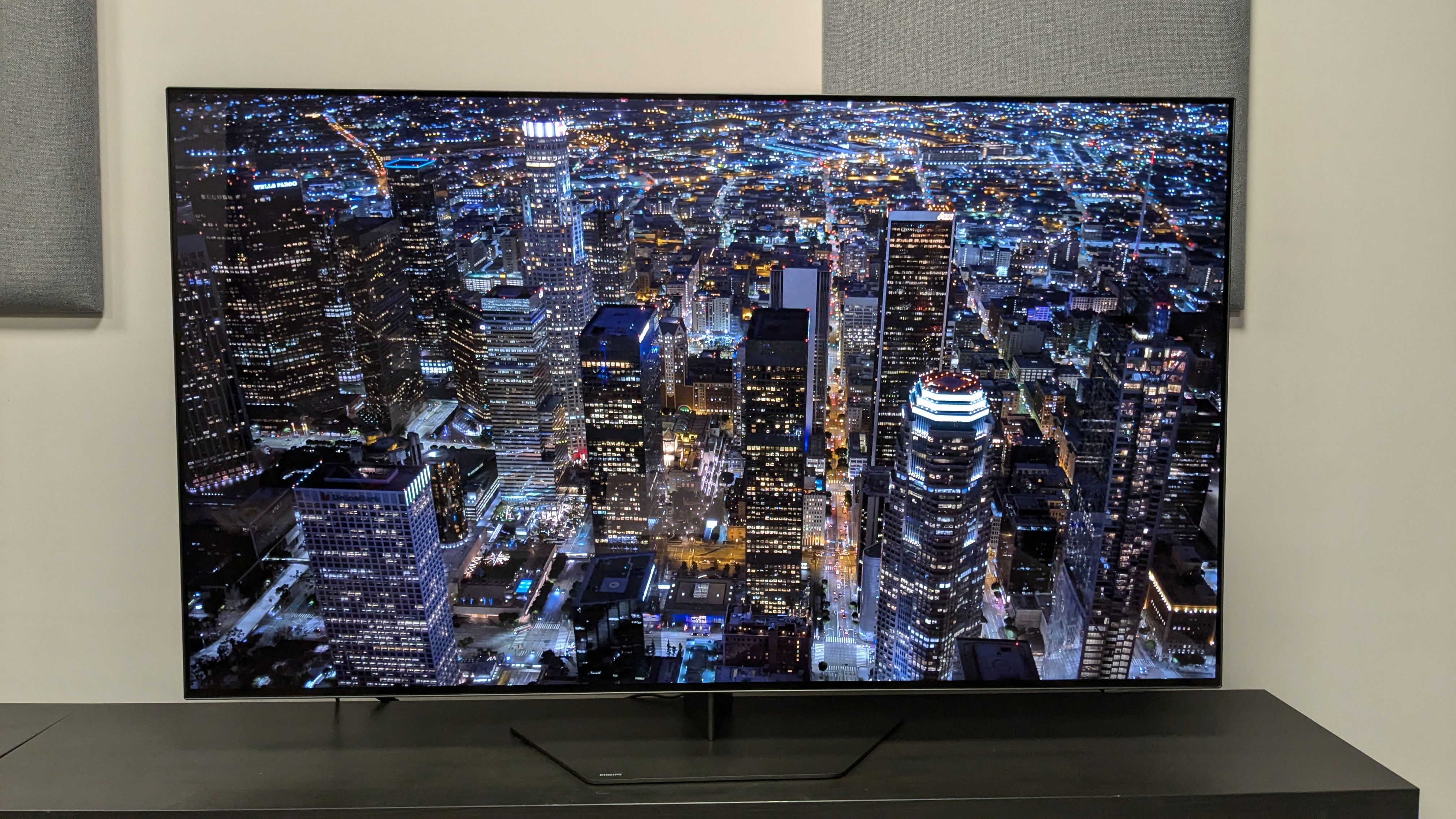
Philips OLED809 review: Picture quality
- Spectacular colour
- Natural detail and textures
- SDR upscaling a bit lacking
Beginning with brightness measurements, the OLED809 yielded HDR peak brightness results of 1,088 and 927 nits in Standard and Filmmaker Mode respectively when measured on a white window pattern covering 10% of the screen. OLED TVs are progressively getting brighter each year and you can now expect premium sets to achieve just under 2,000 nits (the Samsung S95D reached 1,868 nits in Standard mode when I measured it). Philips claims that its 2024 flagship model, the OLED959, can achieve 3,000 nits so it will be interesting to see if it can achieve this.
The OLED809’s full-screen peak HDR brightness in Standard and Filmmaker Mode was 252 and 233 nits, respectively, putting it slightly above the LG C4 This is significantly dimmer than a mini-LED TV set such as the Hisense U6N. which despite being a budget TV can still achieve 500-plus nits full-screen brightness.
Moving onto real-world viewing, I started by watching some standard-definition shows on broadcast TV. The OLED809’s upscaling struggled compared to what I’ve seen on other TVs such as the Samsung S95D, with textures remaining fuzzy. High-def shows looked better but again didn’t receive the same high-quality upscaling I’ve seen elsewhere.
Moving onto 4K HDR sources, I watched a Dolby Vision stream of Star Wars: The Last Jedi on Disney Plus. In the throne room fight sequence, the OLED809 displayed the bold, dynamic reds well, giving them plenty of punch while not being too overpowering. Skin tones and textures in a character’s clothing were accurate and lifelike, and Ambilight added an extra level of vibrancy and immersion to the scene, accurately projecting colours onto the wall behind in line with the action.
When I measured the OLED809’s HDR colour gamut coverage, it yielded BT.2020 and UHDA-P3 results of 74.5% and 99.2%, respectively, both of which are fantastic results.
I next viewed The Batman on the OLED809 to see how it handles this challenging movie’s darker, grittier tones. The OLED809 did a generally great job, delivering excellent shadow detail and black levels and maintaining good textures on objects and clothing in even dimly lit scenes. I found that between the TV’s different Dolby Vision picture modes, Dolby Vision Filmmaker had the most accurate picture, but since it’s significantly dimmer than the other modes it is best saved for low-light viewing environments.
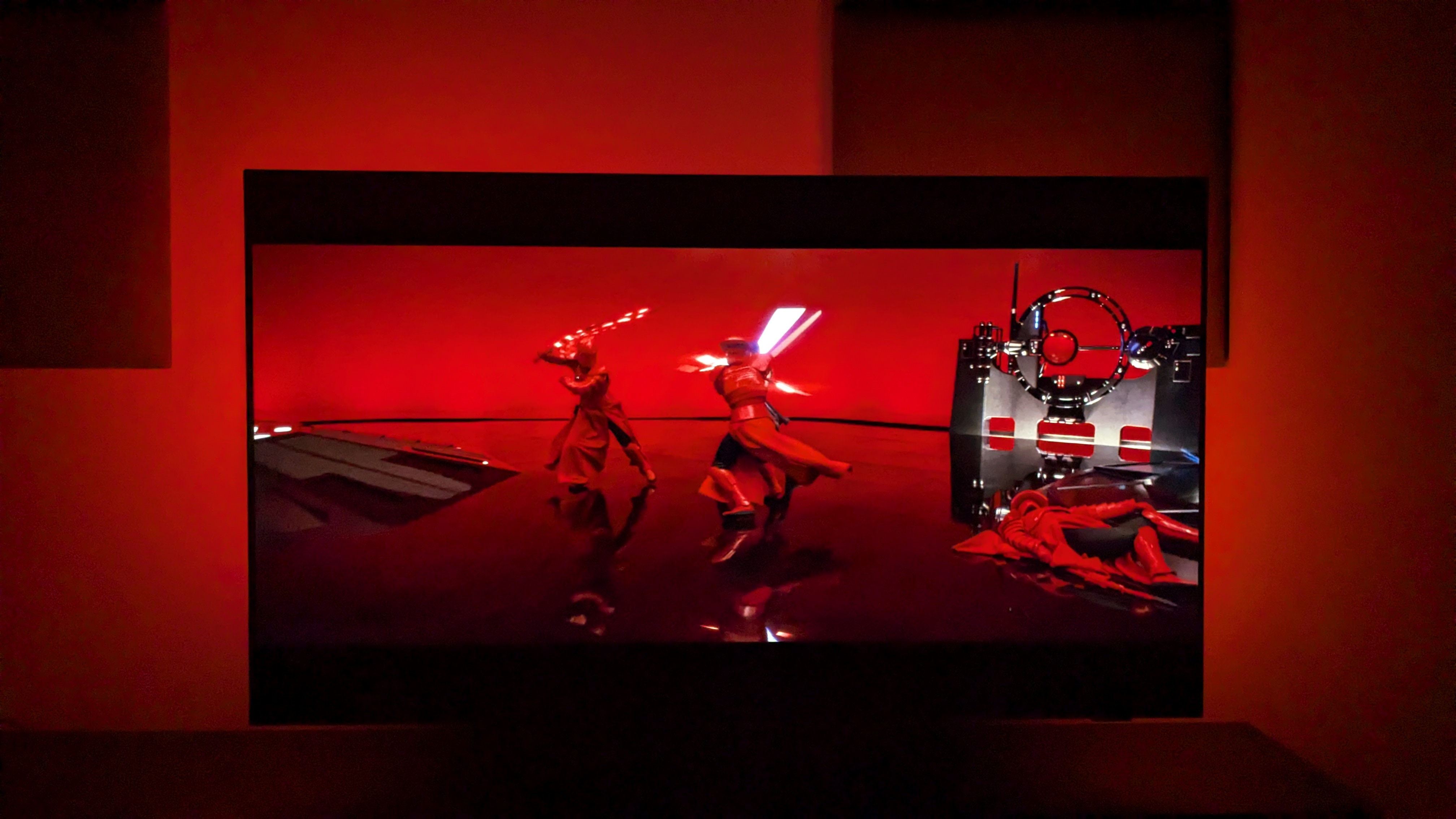
I also found the Light Boost within the picture settings was necessary for any darker scenes viewed in brighter environments, but when turned off it actually made black tones a little more accurate overall – something for those who view in pitch-black conditions to bear in mind.
Moving onto 4K Blu-ray, the OLED809 displayed the punchy colours in the opening sequence of La La Land (in HDR10) with stunning accuracy. The TV’s Filmmaker Mode opts for a more accurate picture and maintains much of a film's original grain. If you find this distracting, the HDR Home Cinema picture preset also does a great job. In La La Land, it showed the vibrant colour and rich contrast between the darker blue and white lights in both the ‘A Lovely Night’ and ‘City Of Stars’ scenes, though the picture was not quite as detailed as in Filmmaker Mode.
I next viewed Oppenheimer, focusing on the black-and-white scenes. The OLED809 displayed a great balance between black and white highlights with a rich range of grey tones in between – something I’ve found cheaper mini-LED TVs, such as the Hisense U6N, struggled with.
The OLED809’s Filmmaker Mode oddly has motion settings turned on by default, although there is a more movie-friendly ‘Movie’ motion setting. Turning these off, the OLED809 did an admirable job handling the long panning bike sequences and fast-paced jet sequences in Top Gun: Maverick, although there was some judder present. Motion settings can be altered, and it’s best to set these to low, as the default 10 blur and judder reduction settings gave Top Gun: Maverick a ‘too smooth’ look. Set to a low level, the OLED809 did a good job with intense action sequences.
When I watched an HD stream of a Man United vs Chelsea football game on Prime Video, the OLED809 benefitted again from some low-level blur and judder reduction. Without it, the TV struggled as the camera panned from left to right during more chaotic sequences of play. With motion settings turned on, the match was enjoyable and easy to watch.
- Picture quality score: 4.5/5
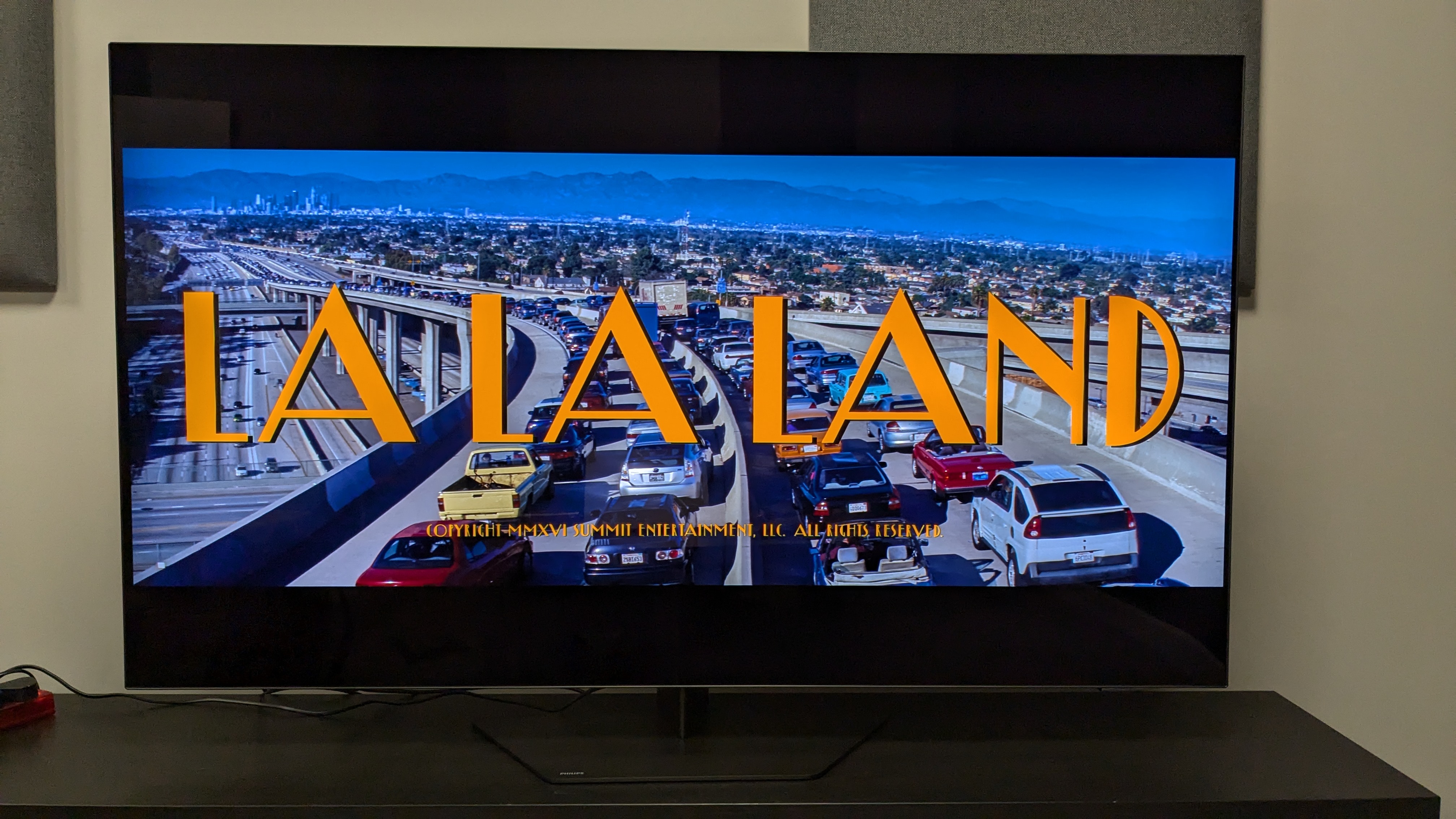
Philips OLED809 review: Sound quality
- Accurate sound placement
- Surprisingly good bass
- Atmos effects can be limited
Despite having only a 2.1-channel speaker array, the OLED809’s built-in sound is surprisingly solid. It may not be one of the best TVs for sound, but certainly puts itself forth as a real contender.
Watching the opening scene of La La Land, the OLED809 nicely handled the horn-heavy score, giving room for strings, brass and percussion instruments to breathe. Bass was well-defined and vocals came through loud and clear in the mix. Other effects such as the scraping of shoes and banging of car roofs during the opening dance number all connected well with the picture, demonstrating excellent sound positioning.
Moving on to the Batmobile chase from The Batman, the OLED809’s speakers delivered hefty and weighty bass from the roaring engine of the Batmobile. Effects such as crunching metal and screeching tyres were once again well-placed around the screen, with an accurate sense of direction throughout.
While accurately placed, The OLED809’s sound was contained to the screen, even with Dolby Atmos soundtracks. During The Batman, the driving rain wasn’t as pronounced as you’d find on TVs such as the Panasonic MZ2000 and Sony A80L, but that's most likely due to the TV’s limited 2.1 speaker array.
Although it’s not best-in-class, the OLED809’s built-in audio surprised me when I tested it against the Panasonic MZ1500, going as far as beating it. If you want the full sound experience, you can add one of the best Dolby Atmos soundbars, but for many, the OLED809’s sound will be more than enough.
- Sound quality score: 4.5/5
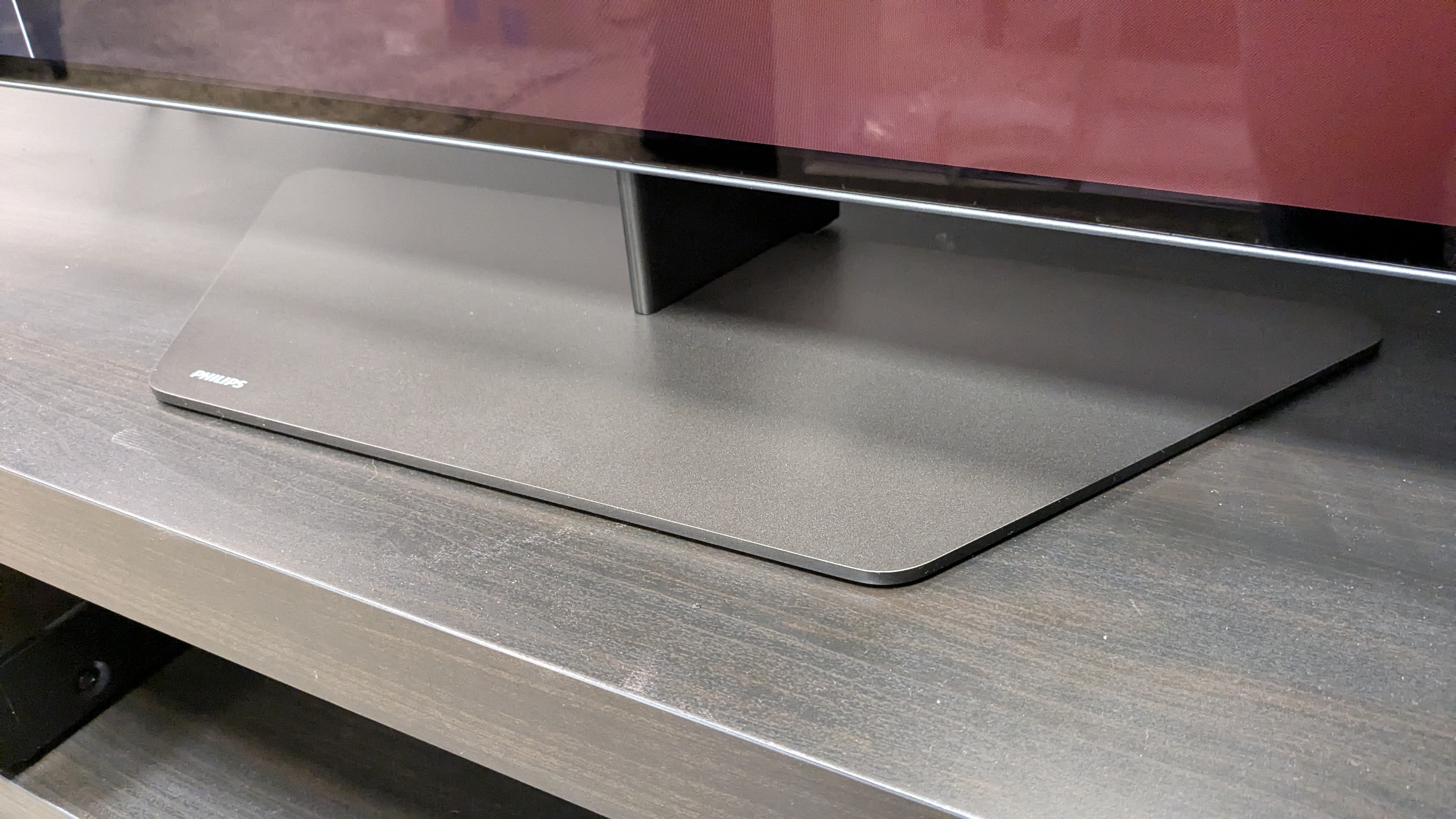
Philips OLED809 review: Design
- Immersive, vibrant Ambilight feature
- Useful swivel stand
- Premium build quality
Ambilight may not be for everyone, but as a fan of the tech, I was delighted to use it once again in this review. The bold colours add an extra layer to movies by making them more immersive. Granted, Ambilight best suits more colourful movies such as Star Wars: The Last Jedi and Ready Player One, but will still add something to any movie. If you find the Ambilight setting that follows the action on screen, you can opt for a solid colour to match your living room or mood and if you really don’t like it, you can turn it off. For me, it continues to be a standout feature that separates Philips from the crowd.
Aside from Ambilight, the OLED809’s design quality is consistent. The screen has a trim profile and narrow bezel and while it’s deeper than other sets, that’s needed to accommodate Ambilight. The supplied metallic grey stand of the 55-inch model I tested is reassuringly weighty and sturdy , with the ability to swivel to accommodate different seating arrangements.
The supplied remote feels premium as well, with a sleek, black metal-like finish. The buttons light up when interacted with – ideal for those viewing in darker conditions. It’s also eco-friendly, doing away with batteries and opting for USB-C and solar recharging similar to TV remotes from Samsung and Hisense.
- Design score: 5/5
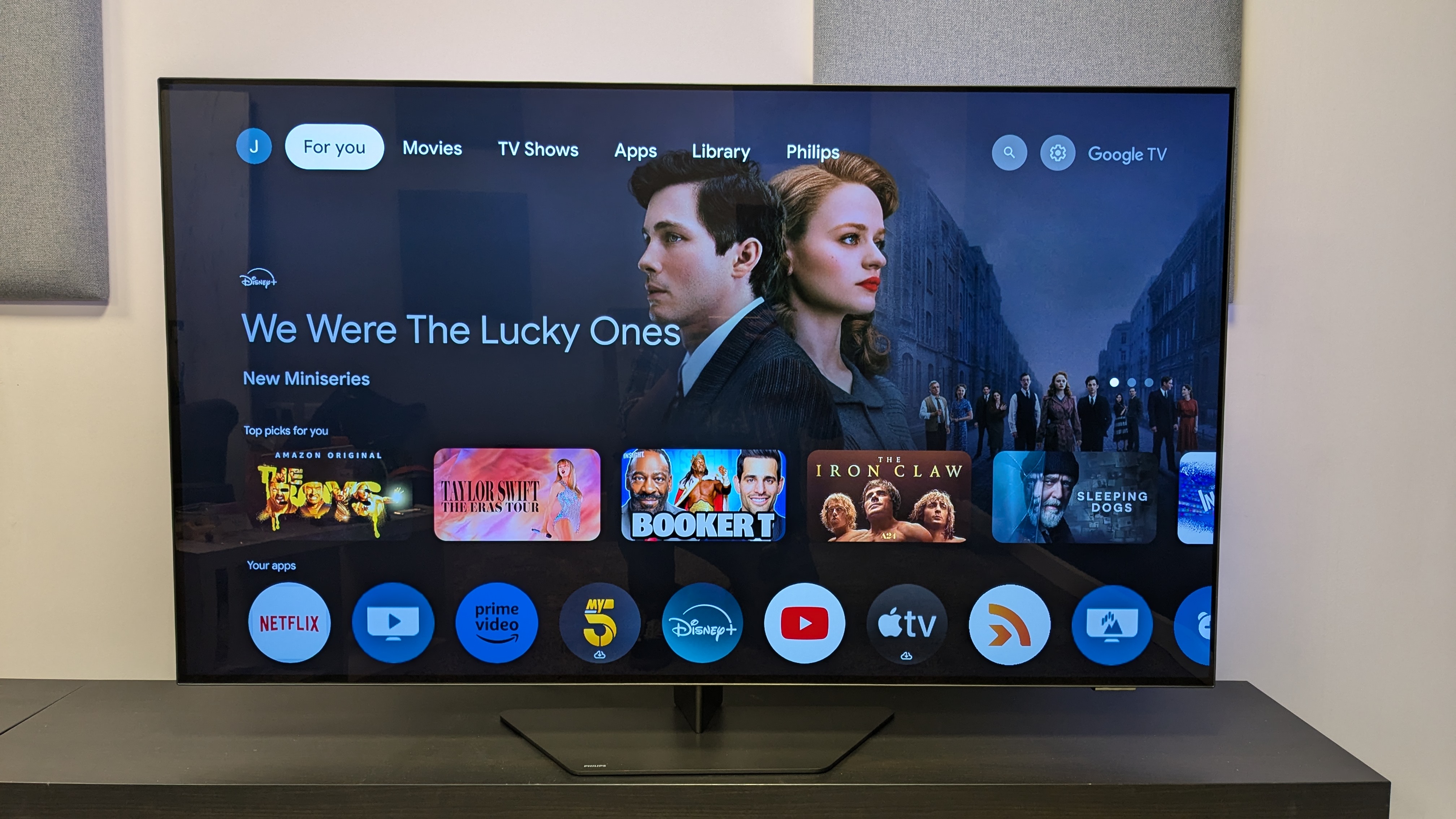
Philips OLED809 review: Smart TV & menus
- Google TV smart TV platform
- No Freeview Play apps
- Good amount of settings to customise pictures
Using Google TV as its smart TV platform, the OLED809’s home menu has large banner ads for flagship streaming releases, along with tailored recommendations based on your viewing rather than irrelevant, screen-cluttering TV show and movie suggestions. The OLED809 provides access to major streaming apps such as Netflix, Prime Video and Disney Plus, but it’s worth noting that Freeview Play is absent, meaning there’s no support for UK-specific streaming apps such as BBC iPlayer, ITVX, and Channel 4. To get these, the best solution is to use a streaming device such as the Amazon Fire TV Stick 4K with the OLED809.
The OLED809 has a good number of picture settings to adjust alongside its numerous picture and audio presets for those who like to tweak their picture and sound. The preset modes are good out-of-the-box, but in some situations such as sport viewing, picture settings will need to be adjusted. Menu navigation is generally easy and smooth, but a more intuitive quick menu like that found in LG’s webOS platform would be welcome.
- Smart TV & menus score: 4/5
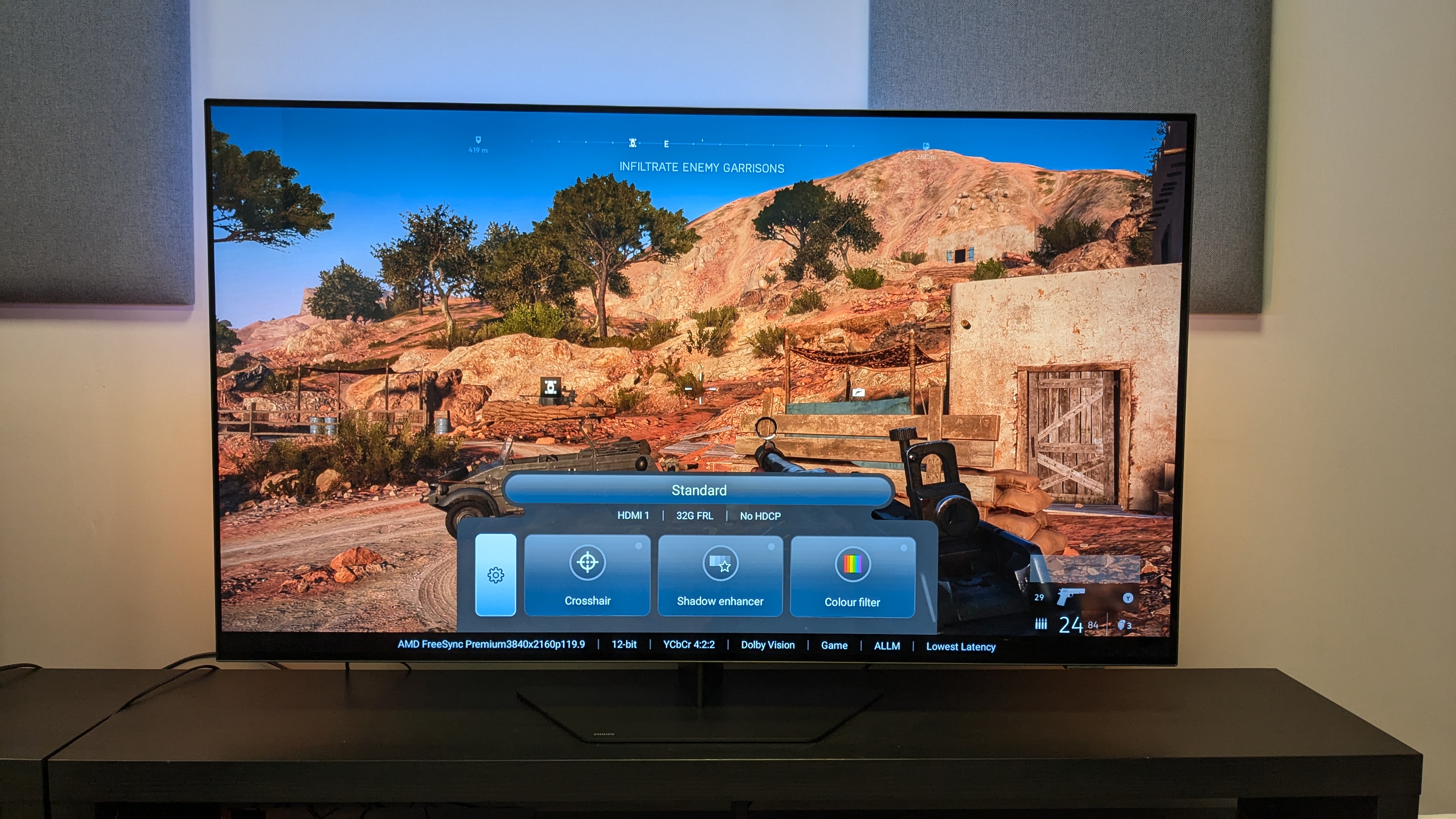
Philips OLED809 review: Gaming
- Well equipped for gaming with 4K 144Hz, VRR and more
- 12.8ms input lag time
- Only two HDMI 2.1 ports
The OLED809 comes with many of the features gamers look for including 4K 144Hz, Dolby Vision gaming, VRR (covering HDMI, AMD FreeSync Premium and Nvidia Gsync) HGiG and ALLM. Unfortunately, it is only equipped with two HDMI 2.1 ports, so those with an Xbox Series X, PS5 and a soundbar will have to swap out devices.
A Game Bar menu allows for customisation of a game’s picture, with settings such as Shadow Enhancer used to give competitive gamers a leg up. Another useful feature for those who frequently like to switch between the same games is the ability to save chosen settings under a profile, allowing for a quick change to the picture without having to re-adjust settings every time.
Gameplay is smooth on the OLED809. Fast-paced and graphically intense sequences in games such as Battlefield V felt effortless, with switching between targets and scanning environments an absolute breeze with no judder to take away from the action. Using a Leo Bodnar 4K HDMI input lag tester to measure input lag, the OLED809 gave a result of 12.8ms at 4K 60Hz. While other TVs such as the LG C4 have an even lower input lag time, this is still below the 15ms most gamers look for.
The OLED809 carries its high-quality picture from movies to gaming, with plenty of refined textures and detail and bold, stunning colours mixed with rich contrast. Games with Dolby Vision, such as Battlefield V, looked particularly good.
- Gaming score: 4.5/5
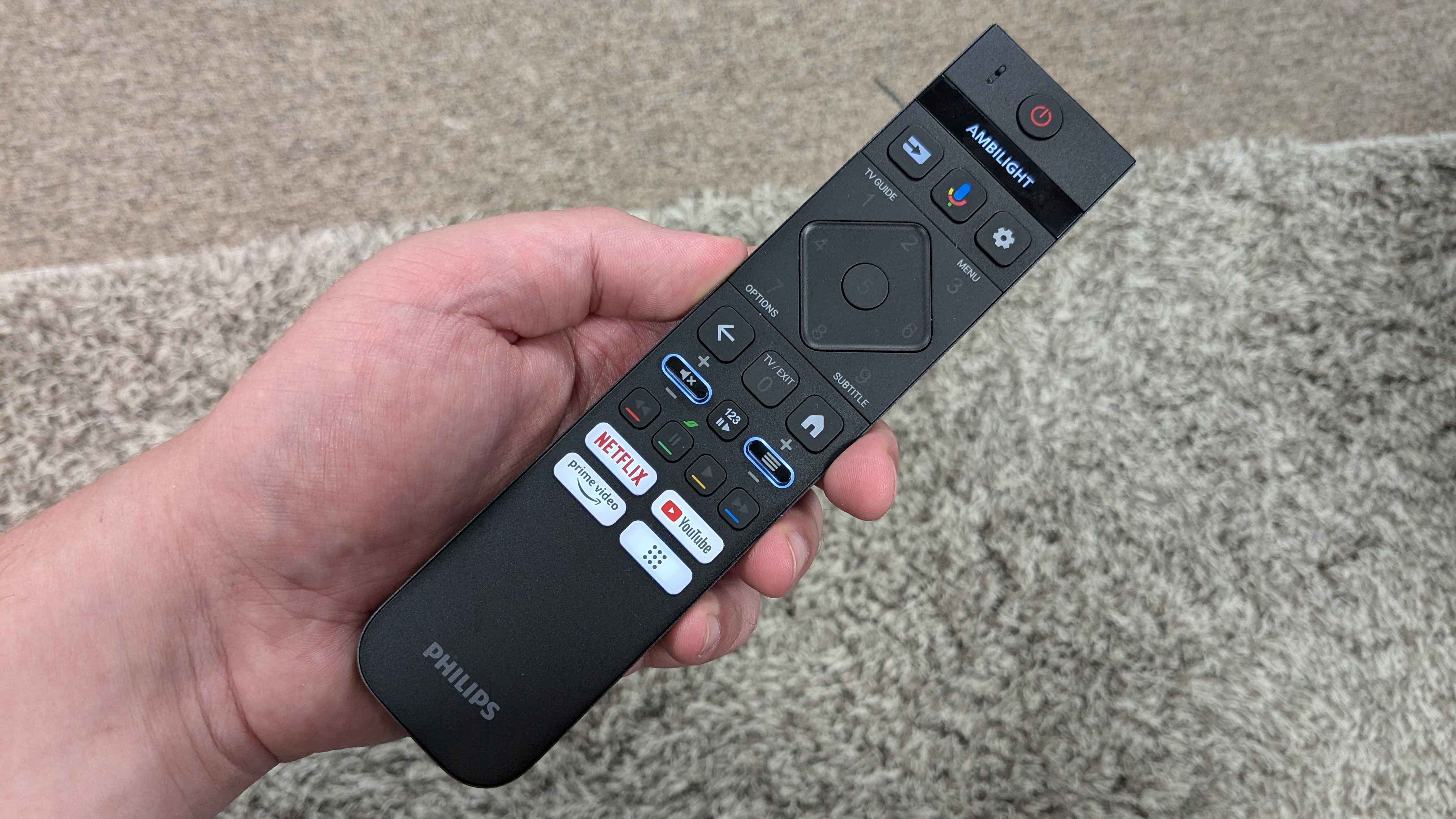
Philips OLED809 review: Value
- Well-priced compared to competition
- Fairly priced for the features and performance
- Feels premium for the money
The OLED809 delivers superb features and picture quality for the price, going toe-to-toe with the likes of other mid-range OLED TVs such as the LG C4, Samsung S90C and Panasonic MZ1500. While it is still a premium model in the grand scheme of things, it offers pretty much everything you’d expect for a TV at this price.
The 55-inch model I tested is priced roughly at £1,599 at the time of writing, and available for £1,499 from some retailers, matching the price of the 55-inch LG C4. For that price, you’re getting much of what the C4 delivers plus the premium Ambilight feature.
Philips’ OLED809 may not beat premium OLED TVs such as the Samsung S95D or Panasonic MZ2000 in terms of picture quality and gaming performance, but for those two models, you’d be looking at paying roughly £2,099 and £1,999, respectively.
- Value score: 4.5/5
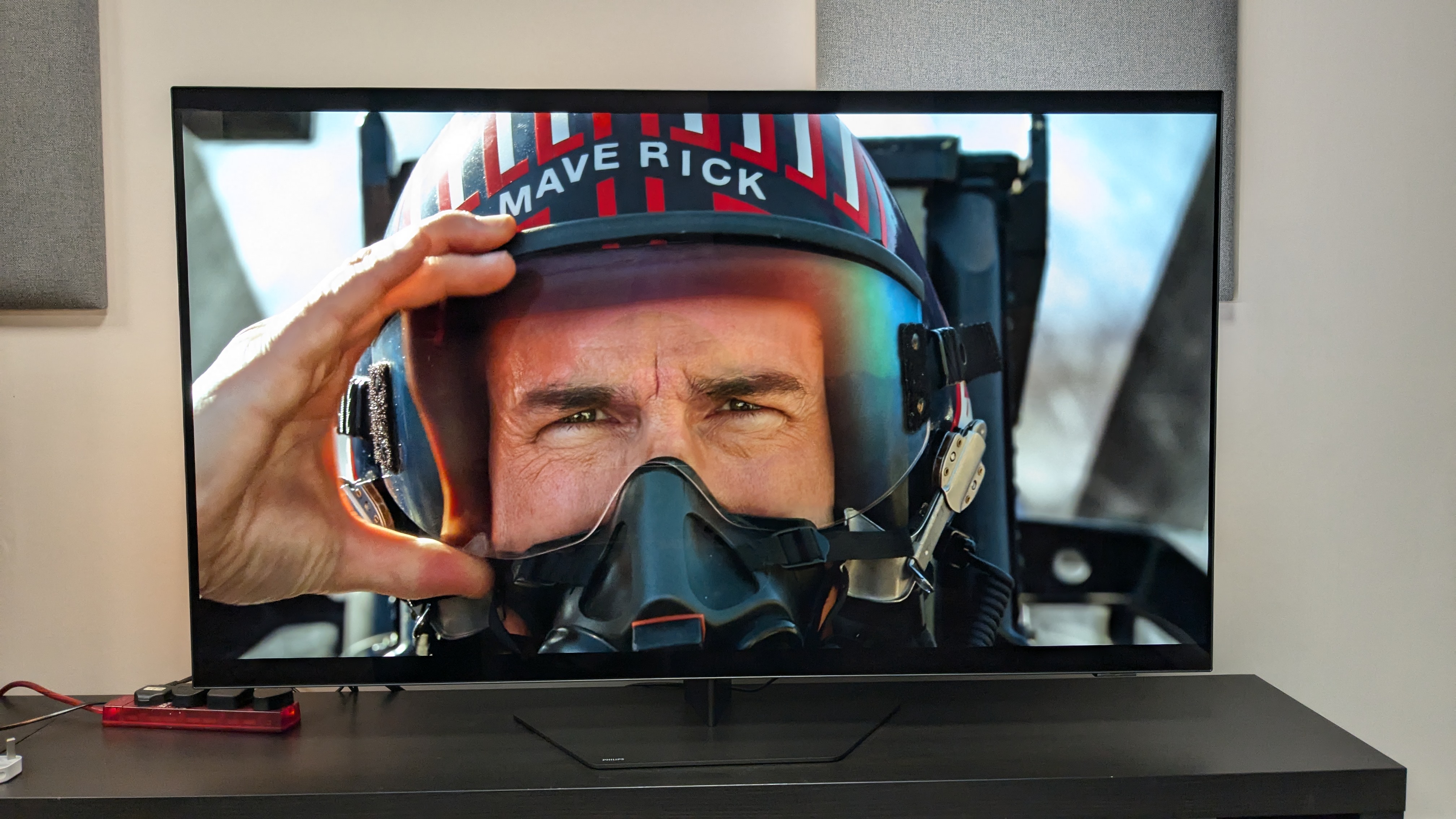
Should I buy the Philips OLED809?
Attributes | Notes | Rating |
|---|---|---|
Features | An extensive list of features for picture, gaming and more | 4.5/5 |
Picture quality | Punchy vibrant colour and excellent detail | 4.5/5 |
Sound quality | Strong, dynamic built-in sound but feels a little narrow | 4.5/5 |
Design | Ambilight is an immersive feature that makes this TV feel premium | 5/5 |
Smart TV and menus | Google TV is a solid smart TV platform, with a good level of settings to adjust pictures | 4/5 |
Gaming | Extensive gaming features and brilliant performance | 4.5/5 |
Value | Still a premium TV, but features and Ambilight make it fair value in the mid-range OLED market | 5/5 |
Buy it if...
You want a unique OLED experience
The OLED809's Ambilight feature brings your movie viewing to another level by adding vibrancy and immersion.
You want a great OLED for gaming
Stacked with gaming features including 4K 144Hz, VRR and with Ambilight as a bonus, the OLED809 is an excellent OLED for gaming.
Don't buy it if...
You watch a lot of broadcast TV shows and movies
The OLED809's picture is great across the board except for its upscaling, which leaves standard-definition movies and TV shows looking quite fuzzy.
You want Freeview Play apps built-in
Like all Philips TVs, the OLED809 does not feature Freeview Play or its associated apps including BBC iPlayer and ITVX.
Also consider
| Row 0 - Cell 0 | Philips OLED809 | LG C4 | Samsung S95D |
Price (55-inch) | £1,499 | £1,499 | £1,999 |
Screen type | OLED EX | OLED EX | QD-OLED |
Refresh rate | 144Hz | 144Hz | 144Hz |
HDR support | Dolby Vision/HDR10+/HDR10/HLG | Dolby Vision/HDR10/HLG | HDR10+/HDR10/HLG |
Smart TV | Google TV | webOS 24 | Tizen |
HDMI 2.1 ports | 2 | 4 | 4 |
LG C4 OLED TV
The LG C4 is the closest rival to the Philips OLED809, matching it in pretty much every area including picture quality and gaming. It has more HDMI 2.1 ports than the OLED809 but doesn't have as good sound or the Ambilight feature. Its webOS 24 smart TV platform, however, is more intuitive.
Read our full LG C4 review
Samsung S95D QD-OLED TV
The Samsung S95D is brighter, has effective anti-glare technology, a 'floating' appearance, and better picture detail compared to the OLED809, but you'll be paying a significant amount more and missing out on Dolby Vision HDR support and Ambilight.
Read our full Samsung S95D review
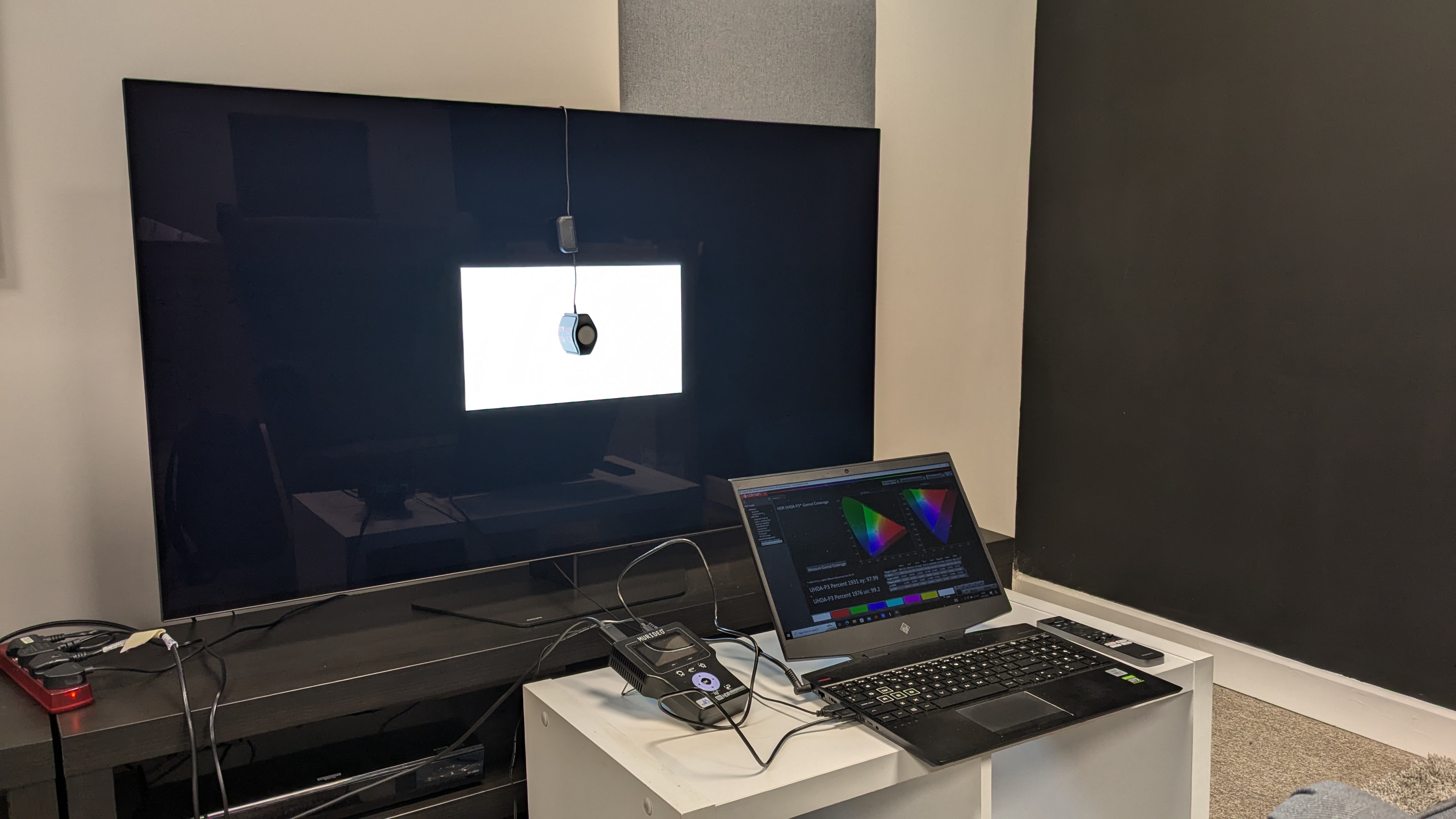
How I tested the Philips OLED809
- Tested using HDR and SDR sources
- Varying lighting conditions used for testing
- Measurements taken using specialised equipment and recorded with Calman
To review the Philips OLED809, I did a combination of subjective testing of picture and sound as well as gaming, and objective testing using specialised equipment to take measurements.
After determining Filmmaker Mode was the OLED809's best picture mode after casual viewing, I watched standard and high-definition broadcast TV and streaming apps, and reference scenes on 4K Blu-rays and streamed shows.
During this testing, I analysed the OLED809's colour, black levels and contrast, motion, upscaling, and detail. For the 4K Blu-ray viewing, I used a Panasonic DP-UB820 player.
I also tested the OLED809's gaming performance using an Xbox Series X.
Measurements of the OLED809 were taken using a colourimeter and test pattern generator with the results recorded by Portrait Displays' Calman calibration software. I took measurements for both SDR and HDR brightness on a full range of white window pattern sizes (1%-100%), colour and grayscale accuracy and HDR colour gamut coverage.
I also tested the OLED809's input lag for gaming using a Leo Bodnar 4K HDMI Input Lag Tester.
You can read an in-depth overview of how we test TVs at TechRadar at that link.
- First reviewed: August, 2024
- Read TechRadar's reviews guarantee

James is the TV Hardware Staff Writer at TechRadar. Before joining the team, he worked at a major UK based AV retailer selling TV and audio equipment, where he was either telling customers the difference between OLED and QLED or being wowed by watching a PS5 run on the LG 65G2. When not writing about the latest TV tech, James can be found gaming, reading, watching rugby or coming up with another idea for a novel.
